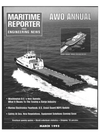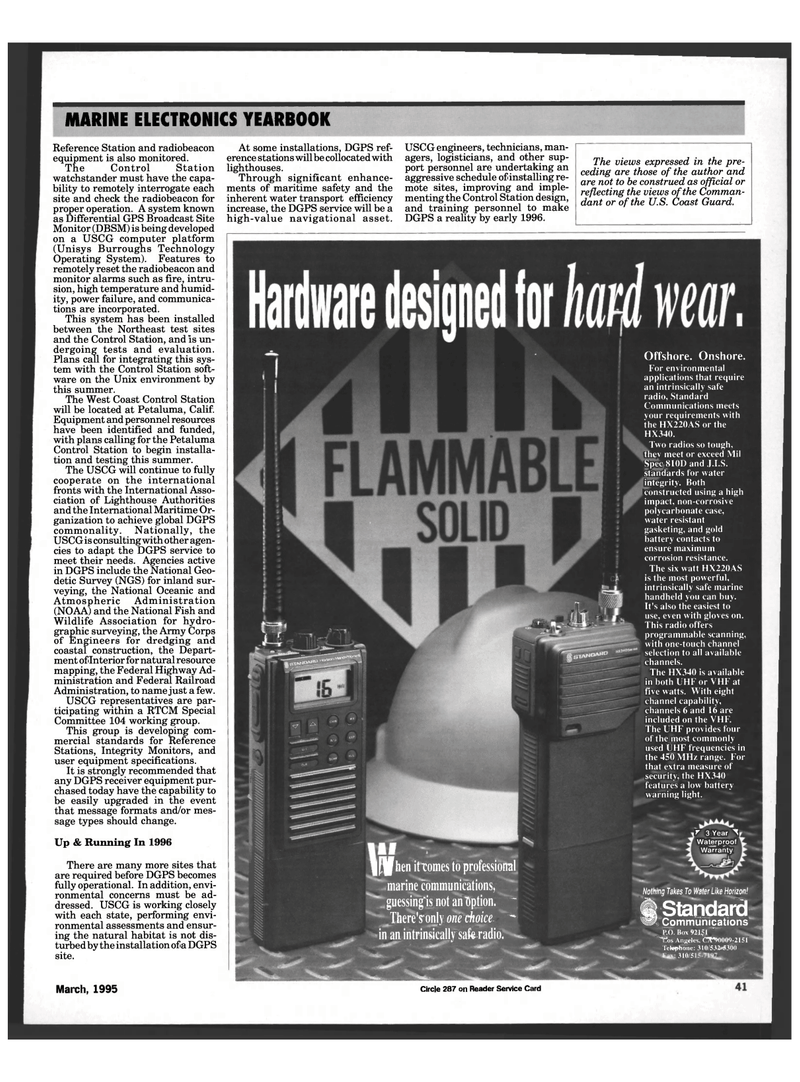
Page 39: of Maritime Reporter Magazine (March 1995)
Read this page in Pdf, Flash or Html5 edition of March 1995 Maritime Reporter Magazine
T 3 Year T
Waterproof
Warranty
MARINE ELECTRONICS YEARBOOK
The views expressed in the pre- ceding are those of the author and are not to be construed as official or reflecting the views of the Comman- dant or of the U.S. Coast Guard.
Reference Station and radiobeacon equipment is also monitored.
The Control Station watchstander must have the capa- bility to remotely interrogate each site and check the radiobeacon for proper operation. A system known as Differential GPS Broadcast Site
Monitor (DBSM) is being developed on a USCG computer platform (Unisys Burroughs Technology
Operating System). Features to remotely reset the radiobeacon and monitor alarms such as fire, intru- sion, high temperature and humid- ity, power failure, and communica- tions are incorporated.
This system has been installed between the Northeast test sites and the Control Station, and is un- dergoing tests and evaluation.
Plans call for integrating this sys- tem with the Control Station soft- ware on the Unix environment by this summer.
The West Coast Control Station will be located at Petaluma, Calif.
Equipment and personnel resources have been identified and funded, with plans calling for the Petaluma
Control Station to begin installa- tion and testing this summer.
The USCG will continue to fully cooperate on the international fronts with the International Asso- ciation of Lighthouse Authorities and the International Maritime Or- ganization to achieve global DGPS commonality. Nationally, the
USCG is consulting with other agen- cies to adapt the DGPS service to meet their needs. Agencies active in DGPS include the National Geo- detic Survey (NGS) for inland sur- veying, the National Oceanic and
Atmospheric Administration (NOAA) and the National Fish and
Wildlife Association for hydro- graphic surveying, the Army Corps of Engineers for dredging and coastal construction, the Depart- ment of Interior for natural resource mapping, the Federal Highway Ad- ministration and Federal Railroad
Administration, to name just a few.
USCG representatives are par- ticipating within a RTCM Special
Committee 104 working group.
This group is developing com- mercial standards for Reference
Stations, Integrity Monitors, and user equipment specifications.
It is strongly recommended that any DGPS receiver equipment pur- chased today have the capability to be easily upgraded in the event that message formats and/or mes- sage types should change.
Up & Running In 1996
There are many more sites that are required before DGPS becomes fully operational. In addition, envi- ronmental concerns must be ad- dressed. USCG is working closely with each state, performing envi- ronmental assessments and ensur- ing the natural habitat is not dis- turbed by the installation of a DGPS site.
March, 1995
Offshore. Onshore.
For environmental applications that require an intrinsically safe radio, Standard
Communications meets your requirements with the HX220AS or the
HX340.
Two radios so tough, thev meet or exceed Mil
Spec 810D and.U.S. standards for water integrity. Both constructed using a high impact, non-corrosive polycarbonate case, water resistant gasketing, and gold battery contacts to ensure maximum corrosion resistance.
The six watt HX220AS is the most powerful, intrinsically safe marine handheld you can buy.
It's also the easiest to use, even with gloves on.
This radio offers programmable scanning, with one-touch channel selection to all available channels.
The HX340 is available in both UHF or VHF at five watts. With eight channel capability, channels 6 and 16 are included on the VHF.
The UHF provides four of the most commonly used UHF frequencies in the 450 MHz range. For that extra measure of security, the HX340 features a low battery warning light. [|f hen it tomes to professional marine communications, guessing is not anDption. ~
There's only one choice • in an intrinsically safe radio.
Nothing Tikes To Water Like Horizon! t ; Standard £ Communications
RO. Box 921I1 ' "ICos Angeles. CTPS0009-2151
Telephone: 310/532*3300 310/5
At some installations, DGPS ref- erence stations will be collocated with lighthouses.
Through significant enhance- ments of maritime safety and the inherent water transport efficiency increase, the DGPS service will be a high-value navigational asset.
USCG engineers, technicians, man- agers, logisticians, and other sup- port personnel are undertaking an aggressive schedule of installing re- mote sites, improving and imple- menting the Control Station design, and training personnel to make
DGPS a reality by early 1996.
Circle 287 on Reader Service Card

 38
38

 40
40
